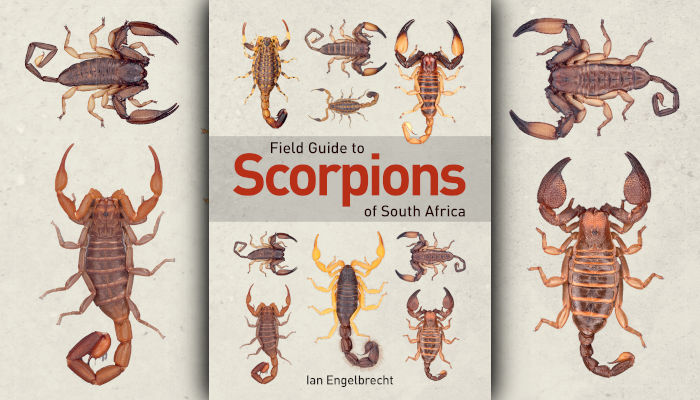‘Can it kill me?’ Scorpions of South Africa: What to look out for!
More about the book!

It’s probably an understatement to say that scorpions are not everyone’s favourite animals. After all, they sting, and some species are dangerous enough to kill humans. But for Dr Ian Engelbrecht, leading expert on southern African scorpions, these creatures are simply fascinating.
‘Scorpions are nocturnal and glow a bright turquoise-green colour under UV light, which makes them easy to find in the dark.’
South Africa has an incredible diversity of scorpions with over 100 species known to science, and many being discovered all the time. Engelbrecht’s fascination started at a young age, when he found a large Burrowing Scorpion drowned at the bottom of the swimming pool where he lived in northern Johannesburg at the time. ‘I got it out with a pool net, and I was transfixed! It was so prehistoric, and yet so intricate and beautiful. The menagerie of animals I had in my bedroom then had to make space for a scorpion …’
Scorpions are, in fact, ancient, with the earliest fossils being over 400 million years old (that’s almost 200 million years before the first dinosaurs appeared). They have changed remarkably little in that time.
The first thing anyone wants to know about a scorpion is ‘Can it kill me?’ A simple rule of thumb is that dangerous scorpion species have a very thick tail and thin pincers. Size is important too – large scorpions have more venom than small ones, and the amount of venom a scorpion injects when it stings is an important determinant of the severity of the sting. These thick-tailed scorpions use their powerful tails to drive their sting deep into the flesh of their prey, or predators in self-defence, to deliver the venom where it will be most effective.
‘In South Africa we only have two scorpion species that are really dangerous to human beings, with one or two others possibly causing serious stings very occasionally. There are only a handful of serious scorpion stings every year, sadly, mostly in children, but deaths can be prevented with proper treatment,’ Engelbrecht says.
So why a book dedicated to scorpions?
‘People spend a lot of time outdoors in nature in South Africa, and they want to know what’s around them. Campers, hikers, 4X4 enthusiasts, and visitors to nature reserves. It’s useful to be able to identify potentially dangerous scorpions, but many people want to identify other species too,’ Engelbrecht says.
Scorpions occur in a wide range of habitats and can be found in almost every part of South Africa. While they do prefer the drier and hotter parts of the country, they can also be found at high altitudes on mountains, and in forests. Searching for scorpions can be a lot of fun, particularly if using an ultraviolet (UV) light at night. Scorpions are nocturnal and glow a bright turquoise-green colour under UV light, which makes them easy to find in the dark. A quick search around camp can help locate any potentially unwanted guests, but it also makes for a fun social activity, which can add an extra dimension to any trip into nature. Engelbrecht actively encourages people to seek out scorpions, photograph them, and upload them to citizen science platforms such as the Virtual Museum (vmus.adu.org.za) or iNaturalist (inaturalist.org).
A Field Guide to Scorpions of South Africa is the first book of its kind in the world – a comprehensive guide to all of the species of the country including important identification features, geographic distribution and behaviour information. It is comprehensively illustrated with standardised neutral background images of each species, including both sexes and colour varieties, which are complemented by natural background images that give a sense of the animals as they appear in the wild, as well as their habitats.
Engelbrecht shares, ‘It took more than ten years to put this book together, and I’m proud of how it’s turned out. The team at Struik have done a remarkable job of making scorpions come to life on the book’s pages. My hope is that this book will open people’s eyes to just how amazing scorpions are, and that it will foster a greater appreciation for all aspects of South Africa’s natural environment’.’
~~~
A Field Guide to Scorpions of South Africa is out now.
This article was originally published in The Penguin Post, a magazine about books for book lovers from Penguin Random House South Africa.
Categories Lifestyle Non-fiction South Africa
Tags A Field Guide to Scorpions of South Africa Ian Engelbrecht Nature Penguin Random House SA Struik Nature The Penguin Post
